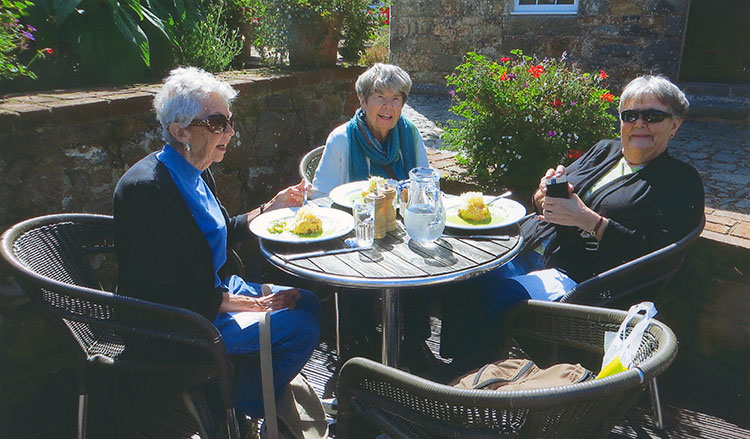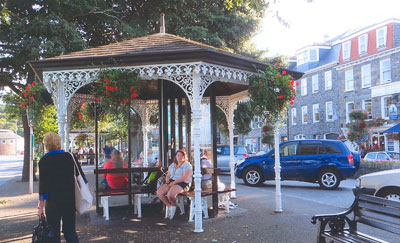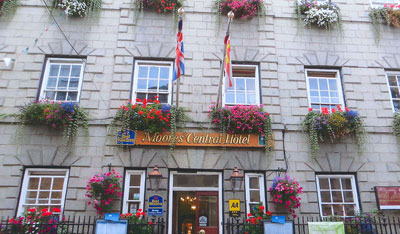A literary inspiration sparks a journey of discovery on the isle of Guernsey
This article appears on page 18 of the April 2013 issue.
by Ann Seibolt; Pleasant Hill, MO
Sometimes reading about a location is the motivation that leads one to go there. That was the case for Mary Pat Meyer, Marge Gardner and me after our book group read “The Guernsey Literary and Potato Peel Pie Society” by Mary Ann Shaffer and Annie Barrows.
The book concerns the only British territory occupied by the Nazis during WWII. It presents Guernsey as a charming, 4-by-6-mile island and its citizens as caring, though they suffered through a 5-year occupation that left the people almost starving.
We had booked the 16-day “Britain & Ireland Highlights Tour” from Grand European Tours (Lake Oswego, OR; 877/622-9109), leaving Sept. 2, 2012. Guernsey, a British Crown dependency that is part of the Channel Islands, was just a hop, skip and jump away, so we thought, ‘Why not?!’
Making plans
We are not what one would call “computer literate,” but we did enter “Guernsey Islands” into Google and found www.visitguernsey.com, with an invitation to request a brochure. When the colorful brochures “A guide to accommodation in Guernsey” and “A visitor’s guide to Guernsey” arrived in the mail, along with a CD of sights to see on that fair isle, we spent many hours dreaming of a visit.
The booklets were full of information. Of equal value was making the email acquaintance of Louise Cain (enquiries@visitguernsey.com).
We learned that the airline Flybe would take us to Guernsey from London Gatwick Airport but not from Heathrow. A call to Grand European Tours arranged our arrival at Gatwick, as we had purchased their land-and-air package. Our original arrival city was Edinburgh, but they had no problem changing that for us.
We found the schedule for Flybe online, and AAA secured the necessary tickets for our flight to Guernsey.
The Best Western Moores Hotel Guernsey (Le Pollet, St Peter Port, Guernsey) was our accommodation choice. It is located in the center of everything in St Peter Port, the capital of Guernsey, and was within walking distance of the bus terminal and wonderful shops and restaurants.
It was built as the residence of a Guernsey merchant, and we felt as if we were guests in his home instead of at a Best Western. The dark woodwork and paneling and the oriental-style carpets combined with a modern bathroom and caring personnel made it a comfortable home on the island.
Our reservation was handled by email along with arrangements for a taxi on our arrival and departure.
We had obtained English pound notes from the bank before leaving home, as we had read that that was “the coin of the realm.” However, we were surprised to learn, during our visit, when we were given a nice, green States of Guernsey one-pound note as change, that Guernsey could print its own currency.
Getting around Guernsey
Guernsey has developed a public bus system that works very well. For one English pound per journey, you can use buses as your sole form of transport. (Bus No. 7 takes you on a tour all around the island.)
The bus terminal was within easy walking distance of our hotel, and there were pretty white gazebos to sit in while awaiting a bus. The drivers were friendly and helpful.
You can take bus No. 4, 7 or 7A to the German Occupation Museum. There we saw equipment used by German forces — a gas mask, radios, range finders, typewriters, guns and field kitchens — as well as old newspapers, currency and diaries kept by the islanders.
The information center was on the waterfront, within a block of our hotel. Staff member Caroline was in control and proved invaluable by contacting people for us and imparting information.
Our next stop was the Village Pavilion in St. Saviour, located in the lush countryside. It was one of the few restaurants that make the potato peel pie. Caroline from the information center had phoned them, and three pies were ready and waiting for the three ladies from the States.
During the occupation, food was scarce, but the Literary Society had refreshments. The plates served to us that sunny day on the patio were delicious, in stark contrast to what those in the book must have experienced in the middle of a war.
A young couple on holiday from Ireland took our picture for us and shared their travel experiences. When it was time to leave, they took us in their car back to St Peter Port.
The bus tour around the island provided an overall picture of the people and countryside. Along the northwestern part of the island, there are beaches and resorts.
Life moves at a slower pace in this small outpost. The speed limit is 35 mph. There is little or no manufacturing, and the economy centers on finance.
The island’s gentler climate tempered the speed of the citizens and seemed to bring out their welcoming smiles.
The buses were a source of new experiences for us and provided views of the beautiful tan-and-cream Guernsey cows in the countryside as well as of the picturesque houses built of the native granite.
We chatted with young girls returning home from school on the bus who plied us with questions about the United States, which they wanted to visit. We also met a woman who was three years old when she, her mother and brother were evacuated to England during WWII. There were hundreds of children who had to leave their fathers behind in Guernsey for five years.
A few sights
There are accredited guides in Guernsey, including Gill Girard, who showed us around the island. She took us on a walking tour along the coast and showed us where there had been German fortifications during the war.
She also showed us the Guernsey Liberation Monument, commemorating the 50th anniversary of the island’s liberation, in 1945. It is made of 50 layers of Guernsey granite and marks the path of the sun.
Gills 2-hour “Potato Peel Pie Tour” costs £6 ($9) per person.
When we were leaving for the airport, we told our taxi driver that we had missed seeing The Little Chapel, made of pieces of broken china, seashells and pebbles. He turned and took us down a narrow road to see it, assuring us we would not miss our flight.
We marveled at how friendly and helpful everyone had been. This trip had turned out to be one of the best ever.
If you have questions about our experiences on this small isle, you may contact us via email c/o ITN.



